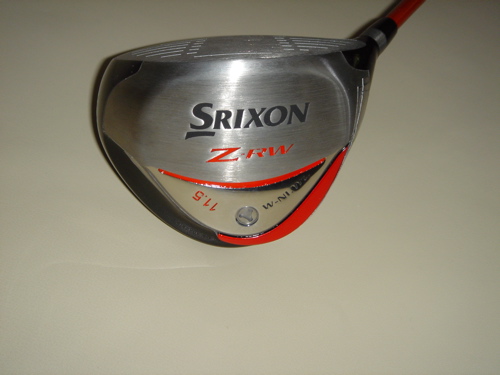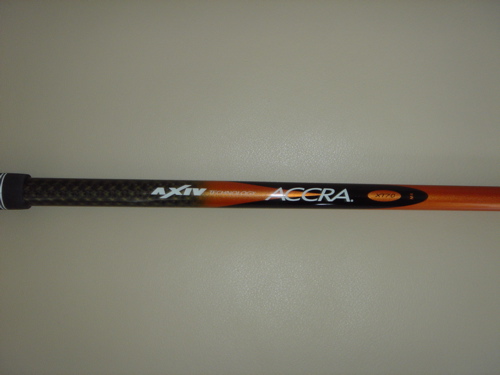It seems that every year the lull of winter and the anticipation of golf season stirs in me a desire to buy new clubs. I’m no Eliot Spitzer, but I have definitely been known to give in to my indulgent urges as evidenced by my storage room full of clubs from years past. In the last two years my new clubs have been drivers and why should this year be any different, right? Yep, I went and got a new driver last Friday. Jones had the best reaction to the news of my latest acquisition, “Damn, you probably own as many drivers as you have irons now!”
Ah, but this year I finally did it the right way- I got fitted the way the pros do. It was something I’ve wanted to do but always found reasons to chicken out. My apprehension is due in large part to the same reason why I don’t take golf lessons- I know the detailed mechanics of a textbook golf swing, I know that my swing doesn’t match that profile, and I get really annoyed with people telling me things that I already know. I have no doubt that the best way to a scratch handicap is to build a fundamentally sound swing, but I also know that a conventional swing has too many aspects that don’t feel right to me now and would require too much time for me to adopt. When you only play once a week if you’re lucky, the prospect of sacrificing several months of golf to undo old habits to adopt new ones with no guarantee of sustainability is not very attractive. If only I had taken lessons when I first picked up the game, those technically correct swing positions would probably feel normal to me now, but alas, my swing now is what it is. And what it is, is an admittedly sloppy mix of an Azinger-esque ultra-strong grip, an unseemly re-grip as my trigger move, leading into an inside takeaway, up to an abbreviated backswing, followed by a too-quick transition to the downswing and finishing with an impact position marked by an exaggerated forward shaft lean. Nice, huh?
But that’s exactly the swing I took with me into The Complete Golfer last week. The process started by my filling out a short questionnaire asking me to describe my ball flight, average yardages, etc. The pro doing my fitting, Andy, had a self-deprecating humor that put me at ease as he reviewed my answers and asked me a few more questions before leading me to one of the hitting bays. Even though I was there for a wood fitting, he let me hit a few warm-up shots with an iron just to get loose. Since I hadn’t swung a club since last autumn, I definitely needed it.
When I was ready to begin, Andy affixed a wireless transmitter to my left wrist connected via a wire to the club I was about to swing. He explained that this club’s shaft had sensors which would measure how my swing loads the shaft at different points and the transmitter would relay that info to the computer in the corner. A few swings with that and he had enough data to pick a particular clubhead/shaft combo as a starting point for the fitting process.
So it was time to start hitting some drivers. But first Andy explained how we’d be evaluating things. We were using Callaway Tour i balls which were most similar to the HX Tours that I normally play, but these were marked with three dots of different colors. On the ground next to the hitting mat was a rectangular box which I was told was a high speed camera. The lens opening was aimed less than two inches ahead of where I was to tee the ball up, and I needed to make sure the colored dots on the ball faced the camera. The sound of impact would trigger the camera to take two shots consecutively so we would have an actual visual picture of the moment after impact to go along with the more conventional numeric and computer generated data (e.g. ball speed, launch angle, spin rate, carry and roll distances, etc).
So I teed up a ball and hit a few shots with the first club/shaft combo. We then looked at the computer to see the results. Ball speed was poor, only about 112mph, spin rate was nice and low, trajectory was erratic and the photos showed why- I de-loft the club with so much forward press at impact that I am often presenting the top of the clubhead to the ball instead of the face. At that point the owner John Ioris popped in to have a look at my swing. After a few more hits, he asked if I intended to take lessons anytime in the near future. I said no because I just don’t have the time to devote to the game to unlearn my habits. And that’s when he replied with the one thing that convinced me I had definitely come to the right place- “That’s exactly the right answer for a lot of people. Ok we can fit you to your current swing.” Just what I wanted to hear.
So then the merry-go-round of shaft/head combos began. Andy would give me a club, I’d hit enough balls to get a consistent grouping of data to know exactly how that particular setup suited me, then he’d make adjustments. He was able to swap shafts onto different clubheads in mere seconds, and the only thing he didn’t have in his fitting arsenal was shorter shafts, so he just instructed me to choke up a bit on every club. The computer data was irrefutable and it was pretty surprising to see how the same swing would produce such markedly different grouping patterns. He could literally predict what the readings would look like as we switched shafts. It was very cool and very fun.
The biggest thing that I learned was that contrary to the conventional wisdom that says if you suck as a golfer you should probably be playing a more flexible shaft, I actually needed a much stiffer shaft. The analogy that Andy gave me was that of dropping a stone in a pond. If there were just one stone, it’s energy would dissipate through the water in perfectly even ripples. That’s the equivalent of what a shaft takes on in a perfectly on-plane swing. In the case of my swing which has a whole lot of excessive and improper movements, it would be like dropping many stones into the pond at once, with each stone’s ripple running into that of the others. That kind of clashing of forces is what my swing is exerting on a golf shaft, and therefore, the best performing shaft for me would be something stiff enough to resist all that chaotic energy.
So thru the science of proper club fitting, Andy handed me a setup that brought my ball speed up into the 140’s, a 15 degree launch angle and retained the hallmark of my swing- the super low spin. The results showed a consistent carry of 230 and a good 20 yards of roll. Not bad, and really quite surprising to me that a shaft can make a 30mph ball speed difference. Incredible. So anyway, here’s my final setup- a Srixon Z-RW head, 11.5 degrees (to counter my de-lofting tendencies), a stiff (M4) Accra AXIV XT70 shaft cut to 44 3/4″, some lead tape added to the back of the head to make up the weight difference from the cut shaft, all resulting in a D3 swing weight:


Now if only it would get warm enough to play golf around here!
very cool place! i know you gave me the 411 about this already but it was fun to read.
i’ve been summoned to setup the first Scamble of the year!
by the way- the same reason you dont change your swing is the same reason why I never picked up snowboarding. i’m a very good skier and i do not go enough to give up a few days of great snow to try to take snowboarding lessons.